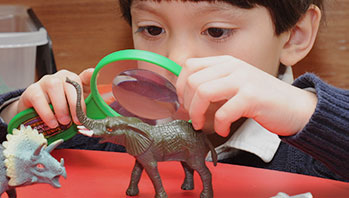- items of varying weights (blocks, books, feathers, plastic animals, stuffed animals, etc.)
- balance scale (or make a simple scale—a clothes hanger with matching plastic buckets tied on each end)
- writing materials
- balance
- heavy
- weigh
MA Standards:
Mathematics/Counting and Cardinality/PK.CC.MA.5: Use comparative language, such as more/less, equal to, to compare and describe collections of objects.
Mathematics/Measurement and Data/PK.MD.MA.2: Compare the attributes of length and weight for two objects, including longer/shorter, same length; heavier/lighter, same weight; holds more/less, holds the same amount.
MA Draft STE Standards:
Physical Sciences/Matter and Its Interactions: Structure and Properties of Matter/PS1.A: Describe, compare, sort and classify objects based on observable physical characteristics, uses, and whether it is manufactured as part of their classroom play and investigations of the natural and human-made world.
Head Start Outcomes:
Logic and Reasoning/Reasoning and Problem Solving: Classifies, compares, and contrasts objects, events, and experiences.
Science Knowledge/Scientific Skills and Method: Uses senses and tools, including technology, to gather information, investigate materials, and observe processes and relationships.
Science Knowledge/Scientific Skills and Method: Observes and discusses common properties, differences, and comparisons among objects.
PreK Learning Guidelines:
Mathematics/Measurement 14: Use nonstandard units to measure length, weight, and amount of content in familiar objects.
Comparing Weight

© Commonwealth of Massachusetts, Department of Early Education and Care (Jennifer Waddell photographer). All rights reserved.
Skill Focus: Predicting, Sorting and Classifying, Compare and Contrast, Vocabulary
Remind children that some animals in Who Sank the Boat? are heavier, or weigh more than others. Let children compare objects and guess which one is heavier.
- Model how to use the balance or home-made scale.
- Place two items of different sizes on the scale. Ask, Which object is heavier?
- Guide children to note that the heavier the item, the lower the scale goes. Explain that the lower side has the heavier object on it. Say, This object is heavier. It weighs more.
- Then encourage children to explore how two objects of the same weight will balance the scale—both sides of the scale would be the same height.
Let children take turns picking two items, predicting which is heavier, then placing them on the scale. Challenge children to make the scale balance with objects of equal weight.
